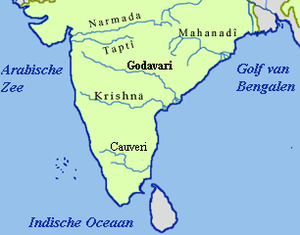Basava Sagara
| Basava Sagara Dam ಬಸವ ಸಾಗರ ಜಲಾಶಯ | |
|---|---|
| Official name | ಬಸವ ಸಾಗರ ಜಲಾಶಯ |
| Location | Narayanapur village, Surapur Taluk, Yadagiri District, Karnataka |
| Coordinates | 16°10′42″N 76°13′28″E / 16.17833°N 76.22444°ECoordinates: 16°10′42″N 76°13′28″E / 16.17833°N 76.22444°E |
| Opening date | 1982 |
| Dam and spillways | |
| Impounds | Krishna River |
| Height | 492.252 meters |
| Length | 10.637 km (6.610 mi) |
| Reservoir | |
| Creates | Basava Sagara/ಬಸವ ಸಾಗರ |
| Total capacity | 37.965 billion cubic feet (1.0750 km3) |
Basava Sagar Dam, previously known as Narayanpur Dam, is a dam constructed across the Krishna River at Siddapur Village in Muddebihal Taluk, Bijapur District, Karnataka, India.[1] The reservoir that it impounds is known as Basava Sagar, and has a total storage capacity of 37.965 tmcft (1.075 km³), with 30.5 tmcft (0.85 km³) live storage.[2][3] The full reservoir level is 492.25 m MSL and the minimum draw down level is 481.6 m MSL. It was a single purpose project meant only for irrigation, but downstream electrical generation and drinking water considerations enter into its management. The dam is 29 meters high and over 10 kilometres long,[2] and has 30 gates for water release.[3] It took Rs. 50.48 crore to complete.[4]
When it was completed in 1982[2] it provided water to irrigate 4.21 lakh hectares in Jewargi taluka in Gulbarga district, Shahapur and Shorapur talukas in Yadgir district, Sindagi and Indi talukas in Bijapur district, and Lingsugur and Devadurga talukas in Raichur district.[5]
In 1992, two of the irrigation gates partially failed.[3] In 2005, there was a collapse of one of the gates in the dam and up to a lakh cusecs of water was being released before emergency actions were effective. The gate broke open on the morning of 6 October and most of the water flow was stopped by the afternoon of the 9th. Basava Sagar reservoir dropped several metres as a result.[5][6]
In April 2011, farmers fearing loss of their crops staged a protest at Narayanpur dam, and forced the staff to release water after officials had shut down releases due to low rainfall and inflows.[7] This type of protests in earlier years, such as the one in April 2005 where large numbers of police prevented the farmer's from releasing the water.[8]As of August 2013, the project has an estimated capacity of 31.47 TMC.
See also
References
- ↑ "Narayanpur Dam". Krishna Bhagya Jal Nigam Ltd. Retrieved 21 June 2016.
- 1 2 3 "Narayanpur Dam: Salient Features of Completed Project". Krishna Bhagya Jala Nigam Limited. Archived from the original on 8 February 2013.
- 1 2 3 Special correspondent (8 October 2005). "Breach raises questions about safety, maintenance of dam". The Hindu. Archived from the original on 18 February 2006.
- ↑ Bhat, Suresh (3 November 2006). "A lot remains to be done for UKP". The Hindu. Archived from the original on 8 February 2013.
- 1 2 Staff (7 October 2005). "Fifth gate of Narayanpur Dam cracks open, water spews out". The Hindu. Archived from the original on 7 March 2006.
- ↑ Staff (10 October 2005). "Outflow from Narayanpur Dam arrested". The Hindu. Archived from the original on 20 February 2006.
- ↑ Staff (19 April 2011). "Farmers forcibly release water from Narayanpur dam". The Hindu. Archived from the original on 16 June 2011.
- ↑ Special correspondent (14 April 2005). "Tension in Narayanpur". The Hindu. Archived from the original on 20 April 2005.
External links
- Photos: "Narayanpur Dam". Mysore Construction Company. Archived from the original on 9 June 2012.
